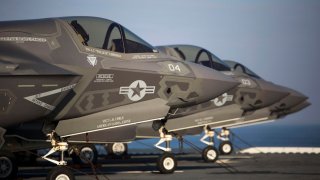How the Marines Hope to Use the F-35 in Electronic Warfare
A vast improvement?
Key point: The electronic domain is one where foreign competitors are trying to get the upper-hand. Here's how the Marines want to stop that from happening.
The U.S. Marine Corps is trying to figure out how to wage electronic warfare now that the service has retired the last of its EA-6B Prowler radar-jamming planes.
The Prowler, a four-seat version of the long-retired, two-seat A-6 attack plane, finally bowed out of service in March 2019.
This first appeared in 2019 and is being reposted due to reader interest.
The Prowler carried AN/ALQ-99 jamming pods under its wings and also could fire High-Speed Anti-Radiation Missiles, or HARMs. Navy and Marine Corps EA-6Bs suppressed and destroyed enemy air defenses in every major American conflict after 1970.
But by 2019 the Prowlers were old and only a few remained in service. The Navy retired its Prowlers in 2015. The last six Marine EA-6Bs spent their final months flying combat missions over the Middle East.
The Navy replaced its EA-6Bs with new EA-18G Growlers, but the Marines opted not to purchase this radar-jamming variant of the F/A-18E/F Super Hornet. Instead, the Corps is trying something new, and spreading the electronic-warfare mission across a wide array of aircraft including stealth fighters and drones.
“The Marine aviation approach to electromagnetic-spectrum operations is a distributed, platform‐agnostic strategy,” the Corps explained in its 2018 aviation plan. “Marine aviation is integrating E.W. systems and Intrepid Tiger II payloads across aviation platforms to provide commanders with an organic and persistent airborne E.W. capability.”
For starters, the Marines are counting on the F-35 stealth fighter with its powerful AN/ASQ-239 electronic-warfare suite, datalink and new weapons partially to replace the EA-6B’s own jamming capability. The Marine Corps plans to buy 420 F-35s to replace, by 2030, all of its older fixed-wing jets.
“The F-35 brings a powerful combination of [electronic warfare], weapons, sensors and reduced signature to the [Marine Air-Ground Task Force],” the Corps explains in its 2019 aviation plan. “F-35 E.W. capabilities include emitter geolocation, identification and parametric data sharing via Link 16 [data-link].”
In addition, future versions of the F-35 should be compatible with the Advanced Anti-Radiation Guided Missile, a new version of the HARM with a better seeker and software. The Marines also believe that the F-35’s electronically-scanned-array radar could, with modification, double as a radar-jammer.
But it’s the AN/ASQ-239 that gives the F-35 its near-term electronic-warfare capabilities. The AN/ASQ-239 “provides the pilot with maximum situational awareness, helping to identify, monitor, analyze and respond to potential threats,” according to manufacturer BAE Systems. “Advanced avionics and sensors provide a real-time, 360-degree view of the battlespace, helping to maximize detection ranges and provide the pilot with options to evade, engage, counter or jam threats.”
But the Marines aren’t assuming the F-35 all by itself will be able to suppress all enemy air defenses. The Corps also is developing the Intrepid Tiger II, a radio- and radar-jamming pod that’s compatible with almost any rotorcraft or fixed-wing plane. The Corps is integrating I.T. II on its AV-8B jump jets, UH-1Y transport helicopters, KC-130J aerial tankers and MV-22B tiltrotors.
“I.T. II is an E.W. payload providing communications electronic-warfare support and electronic-attack capabilities,” the 2019 aviation plan states. “I.T. II deploys with each AV-8B ... detachment and has also completed eight ... deployments with UH-1Y detachments.”
“I.T. II integration with KC-130J ... will be completed and fielded in [fiscal year] ‘19. Development of an I.T. II counter-radar capability for the MV-22B began in F.Y. ’16, [research and development] is ongoing through F.Y. ‘21. Throughout F.Y.18 I.T. II was deployed in support of the 15th, 31st, 26th and 13th [Marine Expeditionary Units].”
As of 2018, the Marines also planned to add Intrepid Tiger II to the current RQ-21 drone and the future Marine Unmanned Expeditionary drone, or MUX. “The initial research and design for an I.T. II E.W. payload on the RQ‐21 began in F.Y. ‘18,” the 2018 aviation plan explained. ‘Payload production is planned for F.Y. ‘21‐’23. … Integrating I.T. II on the RQ‐21 will lay the foundation for further E.W. expansion.”
“Future Marine aviation E.W. capabilities will also be provided by MUX,” the 2018 plan continued. “In addition to providing persistent reconnaissance/ surveillance and communications, MUX will also provide a long-range, persistent, penetrating, responsive, airborne [electronic-warfare] capability.”
David Axe serves as Defense Editor of the National Interest. He is the author of the graphic novels War Fix, War Is Boring and Machete Squad. This first appeared in 2019 and is being reposted due to reader interest.
Image: Reuters

